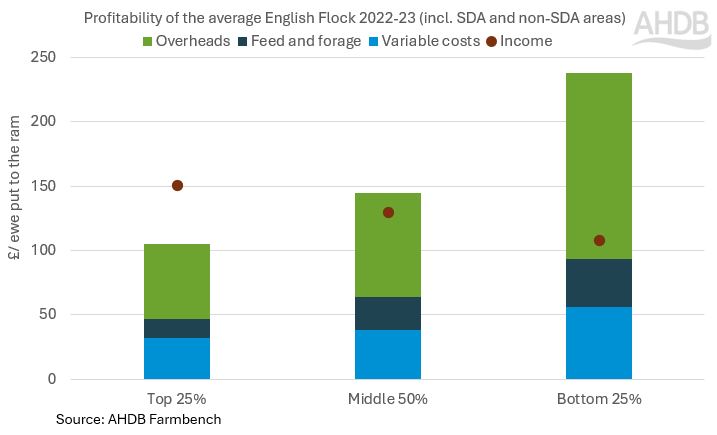Farmbench: what can we learn from benchmarking for breeding sheep in 2022-23?
Tuesday, 8 October 2024
Key Points:
- Only the Top 25% show profitability in 2022-23.
- Overhead costs are key to Top 25% performance (ranked on full economic net margin)
- For non-Severely Disadvantaged Area (non-SDA) flocks’ cost of production strongly correlates to net profit, labour is a key cost.
- For Severely Disadvantaged Area (SDA) flocks’ income and cost of production both correlate to net profit.
As BPS is phased out, it becomes more important for each enterprise on farm to show a profit. Farmbench, AHDB’s benchmarking tool, supports farmers to make proactive and informed decisions to improve their business. The tool allows farmers to record financial and physical performance and compare anonymously to our national and local average datasets. We have analysed the Farmbench data 2022-23, covering lambing 2023, to find the key points for profitability in the average English breeding flock.
The average flock saw an 18% increase in cost of production from 2021-22 to 2022-23. There were small savings within variable costs, but these were outweighed by huge increases in overhead costs, such as labour and property. Overheads (on Farmbench) include costs relating to; labour, machinery and equipment, property, administration, finance, and rental value. Imputed costs are included, for example a wage for any unpaid family labour, and a rental value on owned land.
Despite income increasing slightly, the average Middle 50% (ranked on full economic net margin) was making £19 less profit per ewe put to the ram in 2022-23 compared to the previous year.
Within the 2022-23 data, only the Top 25% were making a profit. The Bottom 25% would not be profitable, even with level of output of the Top 25%. Therefore, cost of production is the key area of focus to improve profits. Overheads are where we see largest increase in Bottom 25% spend, compared to the Top 25%. Overhead costs in the Top 25% were £59/ewe put to the ram, while the Bottom 25% spent £86 more per ewe put to the ram.
Profitability of the average English sheep flock 2022-23 (incl. SDA and non-SDA areas)
Source: AHDB Farmbench
Efficient labour use is important for Top 25% performance in non-SDA breeding flocks. Top performers spent roughly 80% less time on each ewe than the Bottom 25%, resulting in a saving of £75/ewe put to the ram.
Overheads are still a key driver for SDA flock performance. However, income plays more of a role in profitability. Within SDA flocks, the Top 25% had the highest output with 1.41 lambs weaned / ewe put to the ram. Instead of focusing on finishing lambs, they tended to sell store lambs at an average price of £80/head.
There is more to learn from the 2022-23 benchmarks, aside from the key points discussed in this article. To compare your own farm to the national dataset, please contact your regional Farmbench Manager.

Sign up for regular updates
You can subscribe to receive Beef and Lamb market news straight to your inbox. Simply fill in your contact details on our online form.
While AHDB seeks to ensure that the information contained on this webpage is accurate at the time of publication, no warranty is given in respect of the information and data provided. You are responsible for how you use the information. To the maximum extent permitted by law, AHDB accepts no liability for loss, damage or injury howsoever caused or suffered (including that caused by negligence) directly or indirectly in relation to the information or data provided in this publication.
All intellectual property rights in the information and data on this webpage belong to or are licensed by AHDB. You are authorised to use such information for your internal business purposes only and you must not provide this information to any other third parties, including further publication of the information, or for commercial gain in any way whatsoever without the prior written permission of AHDB for each third party disclosure, publication or commercial arrangement. For more information, please see our Terms of Use and Privacy Notice or contact the Director of Corporate Affairs at info@ahdb.org.uk © Agriculture and Horticulture Development Board. All rights reserved.


